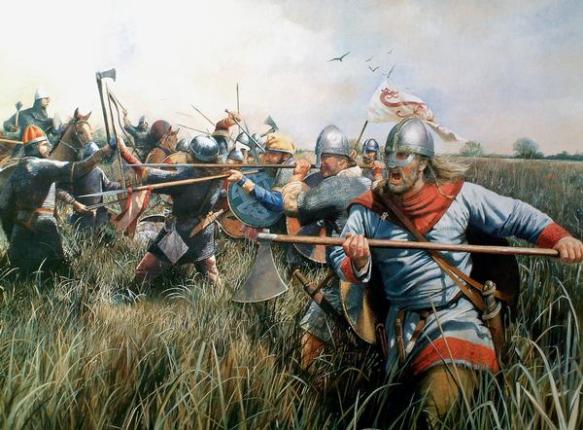King Harold’s subsequent elevation to the throne, his brother Tostig’s banishment and alliance with Harald Sigurdsson of Norway are the stuff of history. It all led to the invasion of Northumbria by Harald and Tostig and the opening battles of the tumultuous year of 1066. After Harald and Tostig’s victory over Earls Edwin and Morcar at Fulford Gate outside York on 20 September 1066, the Anglo-Saxon Chronicle records that York gave hostages to the two victors, with the chronicler John of Worcester noting that 150 were exchanged on either side. If this is the case, it would seem Harald Sigurdsson, despite his victory, was in a mood to do business with Northumbria in his quest for the English throne. The need for further hostages was to be satisfied by a rendezvous at the junction of roads to the east of York.
The Battle of Stamford Bridge has garnered plenty of attention over the years. Its immediate predecessor, the Battle of Fulford Gate, has received less. Nevertheless, Fulford Gate is just as important a battle. The political events leading up to the campaigns of 1066 are very well documented. Suffice it to say that on the one side was the newly crowned King Harold of England, supported locally by his new brothers-in-law Earls Edwin and Morcar, and on the other was Harold’s by now estranged brother Tostig, whose loss of his earldom of Northumbria had all but consumed him while he was in exile. Tostig had found himself an ally, a man already a legend in the Viking world. Harald Sigurdsson (later named ‘Hardraði’ or ‘ruthless’) had been in the Varangian Guard serving the Byzantine emperor and was now the Norwegian king. He was a man of extraordinary physical stature. His claim to the English throne was based on a promise made by King Harthacnut of England to King Magnus of Norway that who ever died first, the other should inherit his kingdom. It was Harthacnut who died first, but Magnus never really prosecuted his claim and so now in 1066, very much at the request of an insistent Tostig, Harold Sigurdsson of Norway sailed to the Humber Estuary with a colossal fleet of up to 500 ships. His wars with Swein Estrithson the king of Denmark were getting him nowhere, and now would be the time he would take the English throne instead.
It is probable that Sigurdsson came to England via the Orkneys where he picked up Earls Paul and Erland and probably Tostig and his Flemish mercenaries, who were by now in Scotland. Scarborough was ransacked on the journey around the coast to the south, after which the combined fleet sailed up the Humber Estuary and then up the Ouse to Riccall where they moored ready to take York. This was on or around 16 September. Edwin and Morcar sent to King Harold the news of the landing and raced to York. The brothers got to York and gave battle to the south of the city at Fulford on 20 September. They appear to have formed up along the Germany Beck, a water feature feeding into the river, pinning one of their flanks on the river itself. It was an ideal defensive position in that this was where route ways into York from the south converged. The Vikings knew they had to defeat the brothers to get to York. On the west flank nearest the river the Norwegians had most of their muscle and it was here they prevailed in the end. Earl Edwin’s forces suffered greatly as they were retreating with their backs to the river in places. Morcar’s men seem to have recoiled as far as Heslington, a mile away to the north-east. The way was open now for Harald and Tostig to take York. Edwin and Morcar, although defeated, would later play a part in the campaign, but for now the speedy response of the new king of England would bring on the next stage.
It seems that after the initial hostage exchanges, Tostig may have prevaricated at York. Northumbria after all was an earldom Tostig had recently held and there must have been room for some negotiation. A total of 150 hostages were exchanged and supplies given to the allied army. Harald and Tostig then returned to their ships at Riccall. By Sunday 24 September, King Harold had arrived at Tadcaster, 8 miles south-west of York. Here he is said to have ‘marshalled his fleet’, a possible reference to some English deserters from Tostig’s fleet who would have found themselves hemmed in by the allies at Riccall. Alternatively, it is just possible that the ships might have been crewed by the Danes sent by the king of Denmark to aid the English against Harald Sigurdsson. Nevertheless, Harold of England swept into York on Monday 25 September apparently unopposed.
History would show that here at Stamford Bridge on the crossing of the Derwent the English King Harold and his men would be ahead of the allies and achieve a famous victory, but once again the issue of the hostage exchange plays centrally in the story. After the crushing and total defeat of the Norwegians at the hands of the English, the remnants who were allowed to sail away by King Harold included Earl Paul of Orkney, who dutifully left hostages behind promising, along with the son of the Norwegian king, never to return.
